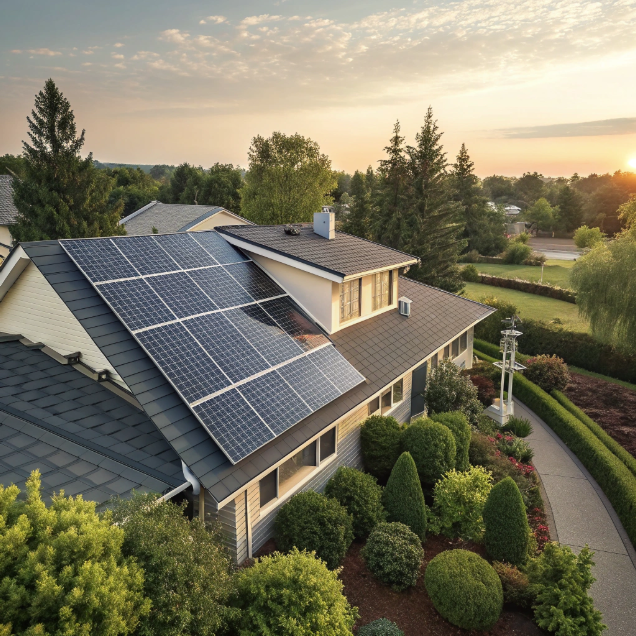Is My Roof Suitable for Solar? How to Get a Free, No-Obligation Assessment in 5 Minutes
by
Is My Roof Suitable for Solar? How to Get a Free, No-Obligation Assessment in 5 Minutes
Worrying about high energy bills? Solar might be your solution, but is your roof even ready for panels? Let's find out quickly!
Most roofs are solar-suitable[^1] if they have adequate sun exposure, proper orientation, and structural integrity. A professional assessment can confirm compatibility and identify any needed modifications for optimal performance.
Now that you know the basics, let's explore what makes a roof truly solar-ready and how you can get that free assessment faster than you can say "energy savings[^2]."
You're in Control: A Simple Guide to How a Home Battery Gives Your Family True Energy Independence
Tired of being at the mercy of utility companies and unpredictable power outages? Take back control today!
Home batteries store excess solar energy for use during outages or peak rate hours, providing backup power and reducing grid dependence. They work with solar panels to maximize self-consumption and protect against rising electricity costs.
Understanding Battery Capacity and Configuration
When I first explored home batteries[^3], I was surprised by how capacity decisions impacted our energy independence. It's like choosing between a small emergency generator and a whole-house system - the right size depends on your needs.
Key Battery Considerations:
- Capacity: Measured in kWh, determines how long batteries can power essential loads
- Power Rating: How many appliances can run simultaneously
- Solar Integration: Batteries work best when paired with properly sized solar systems
| Battery Type | Ideal For | Average Cost | Lifespan |
|---|---|---|---|
| Lead-Acid | Budget-conscious backup | $5,000-$7,000 | 5-7 years |
| Lithium-Ion | Daily cycling with solar | $10,000-$15,000 | 10-15 years |
| Saltwater | Eco-friendly option | $12,000-$18,000 | 15+ years |
The real game-changer comes when you understand how batteries interact with time-of-use rates. During peak hours when electricity costs surge, your battery can power your home instead of drawing expensive grid power.
Home batteries require solar panels to function. False
While batteries maximize solar benefits, they can charge from the grid during off-peak hours for backup power.
Battery storage eliminates electricity bills completely. False
Batters reduce bills significantly but typically don't eliminate them entirely unless paired with oversized solar systems.
Why You Should Be Worried About the Aging Power Grid (And How to Protect Your Home Today)
Power outages are increasing dramatically nationwide. Is your home prepared for the next grid failure?
The aging grid faces increased failure risks from extreme weather, high demand, and infrastructure decay. Solar-plus-storage systems provide immediate backup power and long-term protection against rising outage frequency and duration.
Grid Vulnerabilities and Protective Solutions
Having experienced multiple extended outages myself, I've seen how vulnerable our centralized power system has become. The 2021 Texas freeze and California wildfire outages demonstrated how quickly modern life can grind to halt.
Grid Protection Strategy Breakdown:
Immediate Solutions:
- Whole-home battery systems (8-24 hours of backup)
- Critical loads panels (essentials only)
- Automatic transfer switches
Long-term Planning:
- Solar-plus-storage systems
- Energy efficiency upgrades
- Smart home energy management
The most cost-effective approach combines solar generation with battery storage. This creates a microgrid that powers your home independently during outages while reducing your monthly electricity costs when the grid is operational.
Solar panels work during power outages. False
Standard grid-tied solar systems automatically shut off during outages for safety unless paired with battery storage.
Home batteries can power entire houses indefinitely. False
Battery runtime depends on capacity and usage; most systems prioritize essential loads for extended backup.
What Does a Solar Installation ACTUALLY Involve? A Step-by-Step Visual Guide for Your Home
Considering solar but nervous about the installation process[^4]? The reality is much simpler than you might imagine!
Solar installation involves site assessment, design, permitting, mounting Hardware installation, panel placement, electrical work, inspection, and activation. Most residential installations typically take 1-3 days with minimal disruption to your daily routine.
The Installation Journey Demystified
I'll never forget watching my own solar installation - it was fascinating how quickly and efficiently the process unfolded. The crew arrived at 8 AM and by lunchtime, the racking system was already taking shape.
Installation Timeline Breakdown:
Week 1-2: Planning Phase
- Engineering assessment and system design
- Permit applications and utility approval
- Equipment delivery scheduling
Week 3: Installation Phase
- Day 1: Roof mounting and rack installation
- Day 2: Panel placement and electrical wiring
- Day 3: Inverter connection and system testing
Week 4-6: Activation Phase
- Local inspections and utility approval
- Permission to operate granted
- System monitoring setup
The most surprising part was how little disruption we experienced. The installers maintained excellent communication, protected our property, and cleaned up thoroughly each day.
Solar installations require major home renovations. False
Most installations involve minimal structural changes and preserve roof integrity with professional mounting systems.
Installation typically takes several weeks of construction. False
Active installation usually completes in 1-3 days; longer timelines involve planning and permit phases.
Conclusion
Understanding solar suitability, battery benefits, grid protection, and installation reality empowers informed energy decisions for your home's future.
[^1]: Explore this link to understand the key factors that determine if your roof is ready for solar panels.
[^2]: Explore how solar energy can significantly reduce your energy bills and save you money.
[^3]: Learn how home batteries can enhance your solar energy system and provide backup power during outages.
[^4]: Get insights into the solar installation process and what to expect during the setup.
Popular Posts
You may also be interested in:




